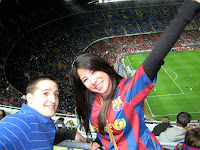The second field trip I took with my Barcelona Past & Present class was to the medieval area of Barcelona known as El Born. The architecture that remains there from the medieval period is stunning. On the field trip, I saw the stone foundation of the city of Barcelona, built atop Mont Taber.

 I also saw the columns of Augustus (pictured below). These neo-classical Greek-Roman columns, which are two thousand years old, provided the basic design for columns built all over the world, including those of the White House. I learned on the field trip that this is because the Romans that established the city that originally stood where Barcelona stands today formed the first ideals of democracy. Western culture has utilized Greek-Roman architectural designs in order to reflect its use of the democracy system of politics. I found this very interesting since I go to school close to Washington D.C. and see the White House often.
I also saw the columns of Augustus (pictured below). These neo-classical Greek-Roman columns, which are two thousand years old, provided the basic design for columns built all over the world, including those of the White House. I learned on the field trip that this is because the Romans that established the city that originally stood where Barcelona stands today formed the first ideals of democracy. Western culture has utilized Greek-Roman architectural designs in order to reflect its use of the democracy system of politics. I found this very interesting since I go to school close to Washington D.C. and see the White House often. I was able to see the Jewish quarter of Barcelona, as well as the outside of the Catedral and some amazing masonry still standing from Roman times (shown below). I found it interesting that each of the various gargoyles, animals, and angels carved into the masonry represented a different family.














